Project Management Analysis: Leadership, Stakeholders, and Motivation
VerifiedAdded on 2021/12/03
|15
|6734
|25
Report
AI Summary
This report analyzes the Chinook Choppers project, focusing on leadership and motivation in project management. It identifies key internal stakeholders like James, Carl, and Boyd, and external stakeholders such as the customer Conway and suppliers. The report examines stakeholder expectations, project challenges like tight deadlines and faulty parts, and consequences of delays. It discusses strategies for stakeholder collaboration, including real-time updates and feedback. The analysis explores project management theories, including the theory of execution and control, and the PMBOK framework. The report evaluates project planning, execution, and control processes, highlighting the importance of scope, cost, and risk management. The report also covers the theory of management, including initiation, planning, execution, monitoring, and closing of the project.
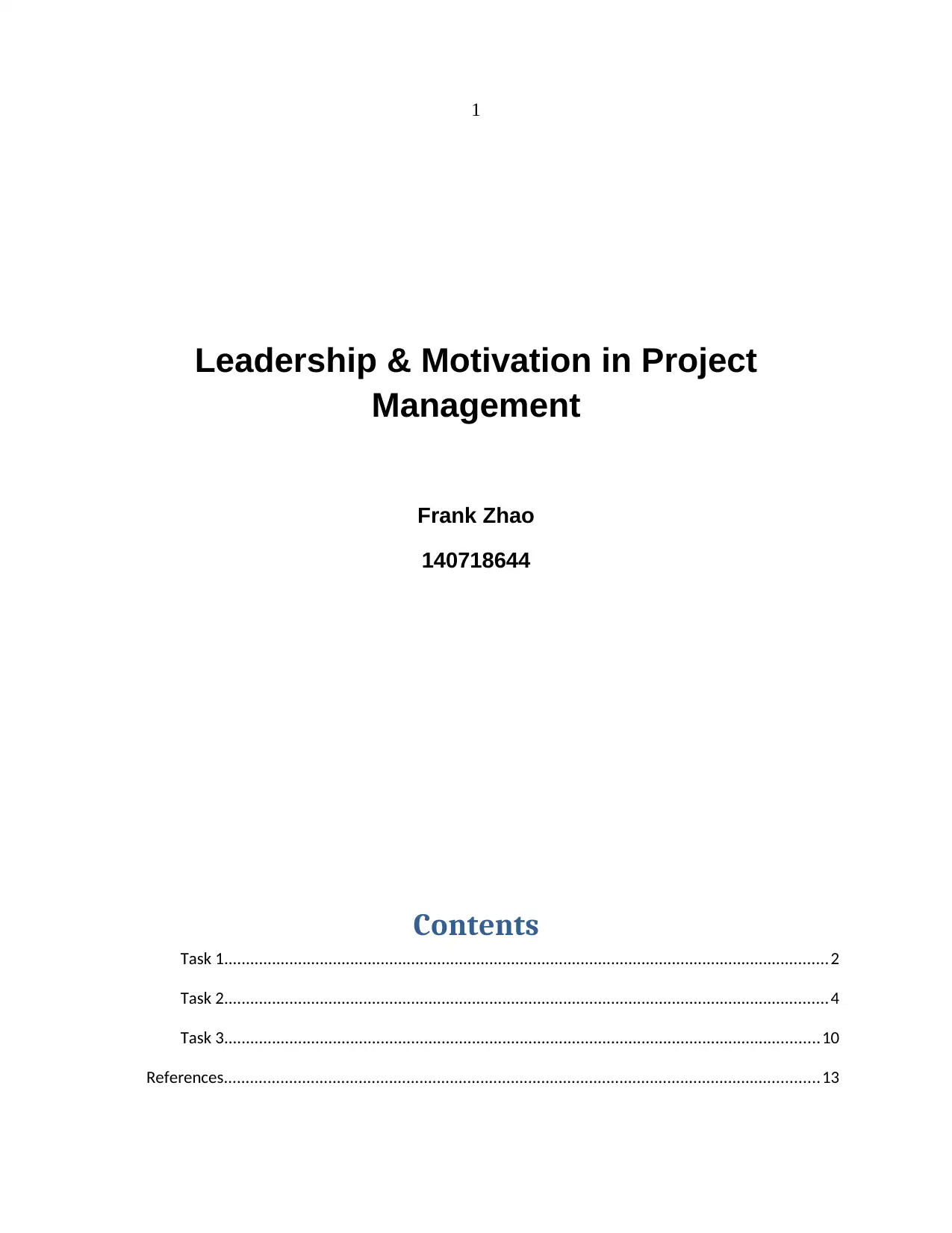
1
Leadership & Motivation in Project
Management
Frank Zhao
140718644
Contents
Task 1...........................................................................................................................................2
Task 2...........................................................................................................................................4
Task 3.........................................................................................................................................10
References.........................................................................................................................................13
Leadership & Motivation in Project
Management
Frank Zhao
140718644
Contents
Task 1...........................................................................................................................................2
Task 2...........................................................................................................................................4
Task 3.........................................................................................................................................10
References.........................................................................................................................................13
Paraphrase This Document
Need a fresh take? Get an instant paraphrase of this document with our AI Paraphraser
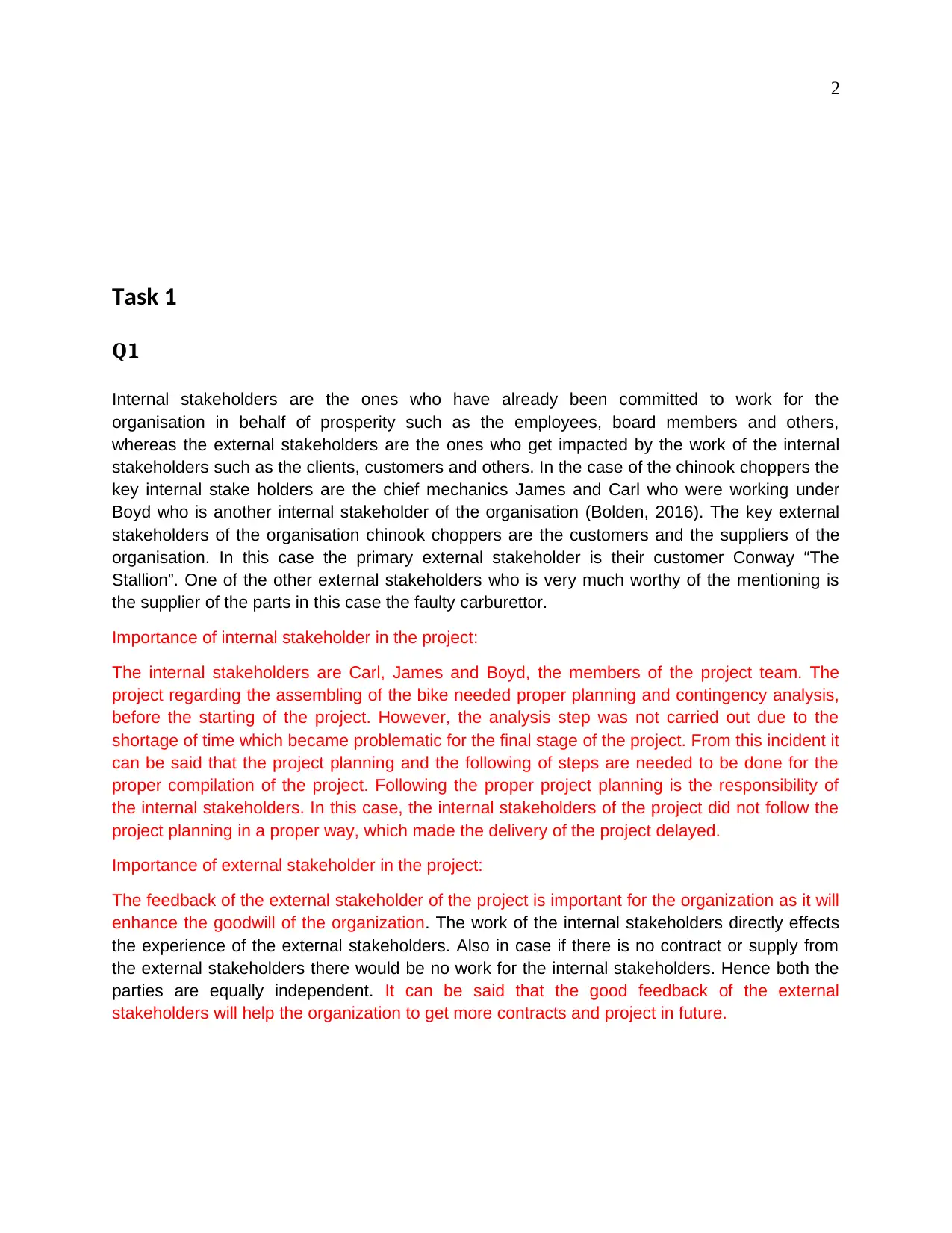
2
Task 1
Q1
Internal stakeholders are the ones who have already been committed to work for the
organisation in behalf of prosperity such as the employees, board members and others,
whereas the external stakeholders are the ones who get impacted by the work of the internal
stakeholders such as the clients, customers and others. In the case of the chinook choppers the
key internal stake holders are the chief mechanics James and Carl who were working under
Boyd who is another internal stakeholder of the organisation (Bolden, 2016). The key external
stakeholders of the organisation chinook choppers are the customers and the suppliers of the
organisation. In this case the primary external stakeholder is their customer Conway “The
Stallion”. One of the other external stakeholders who is very much worthy of the mentioning is
the supplier of the parts in this case the faulty carburettor.
Importance of internal stakeholder in the project:
The internal stakeholders are Carl, James and Boyd, the members of the project team. The
project regarding the assembling of the bike needed proper planning and contingency analysis,
before the starting of the project. However, the analysis step was not carried out due to the
shortage of time which became problematic for the final stage of the project. From this incident it
can be said that the project planning and the following of steps are needed to be done for the
proper compilation of the project. Following the proper project planning is the responsibility of
the internal stakeholders. In this case, the internal stakeholders of the project did not follow the
project planning in a proper way, which made the delivery of the project delayed.
Importance of external stakeholder in the project:
The feedback of the external stakeholder of the project is important for the organization as it will
enhance the goodwill of the organization. The work of the internal stakeholders directly effects
the experience of the external stakeholders. Also in case if there is no contract or supply from
the external stakeholders there would be no work for the internal stakeholders. Hence both the
parties are equally independent. It can be said that the good feedback of the external
stakeholders will help the organization to get more contracts and project in future.
Task 1
Q1
Internal stakeholders are the ones who have already been committed to work for the
organisation in behalf of prosperity such as the employees, board members and others,
whereas the external stakeholders are the ones who get impacted by the work of the internal
stakeholders such as the clients, customers and others. In the case of the chinook choppers the
key internal stake holders are the chief mechanics James and Carl who were working under
Boyd who is another internal stakeholder of the organisation (Bolden, 2016). The key external
stakeholders of the organisation chinook choppers are the customers and the suppliers of the
organisation. In this case the primary external stakeholder is their customer Conway “The
Stallion”. One of the other external stakeholders who is very much worthy of the mentioning is
the supplier of the parts in this case the faulty carburettor.
Importance of internal stakeholder in the project:
The internal stakeholders are Carl, James and Boyd, the members of the project team. The
project regarding the assembling of the bike needed proper planning and contingency analysis,
before the starting of the project. However, the analysis step was not carried out due to the
shortage of time which became problematic for the final stage of the project. From this incident it
can be said that the project planning and the following of steps are needed to be done for the
proper compilation of the project. Following the proper project planning is the responsibility of
the internal stakeholders. In this case, the internal stakeholders of the project did not follow the
project planning in a proper way, which made the delivery of the project delayed.
Importance of external stakeholder in the project:
The feedback of the external stakeholder of the project is important for the organization as it will
enhance the goodwill of the organization. The work of the internal stakeholders directly effects
the experience of the external stakeholders. Also in case if there is no contract or supply from
the external stakeholders there would be no work for the internal stakeholders. Hence both the
parties are equally independent. It can be said that the good feedback of the external
stakeholders will help the organization to get more contracts and project in future.
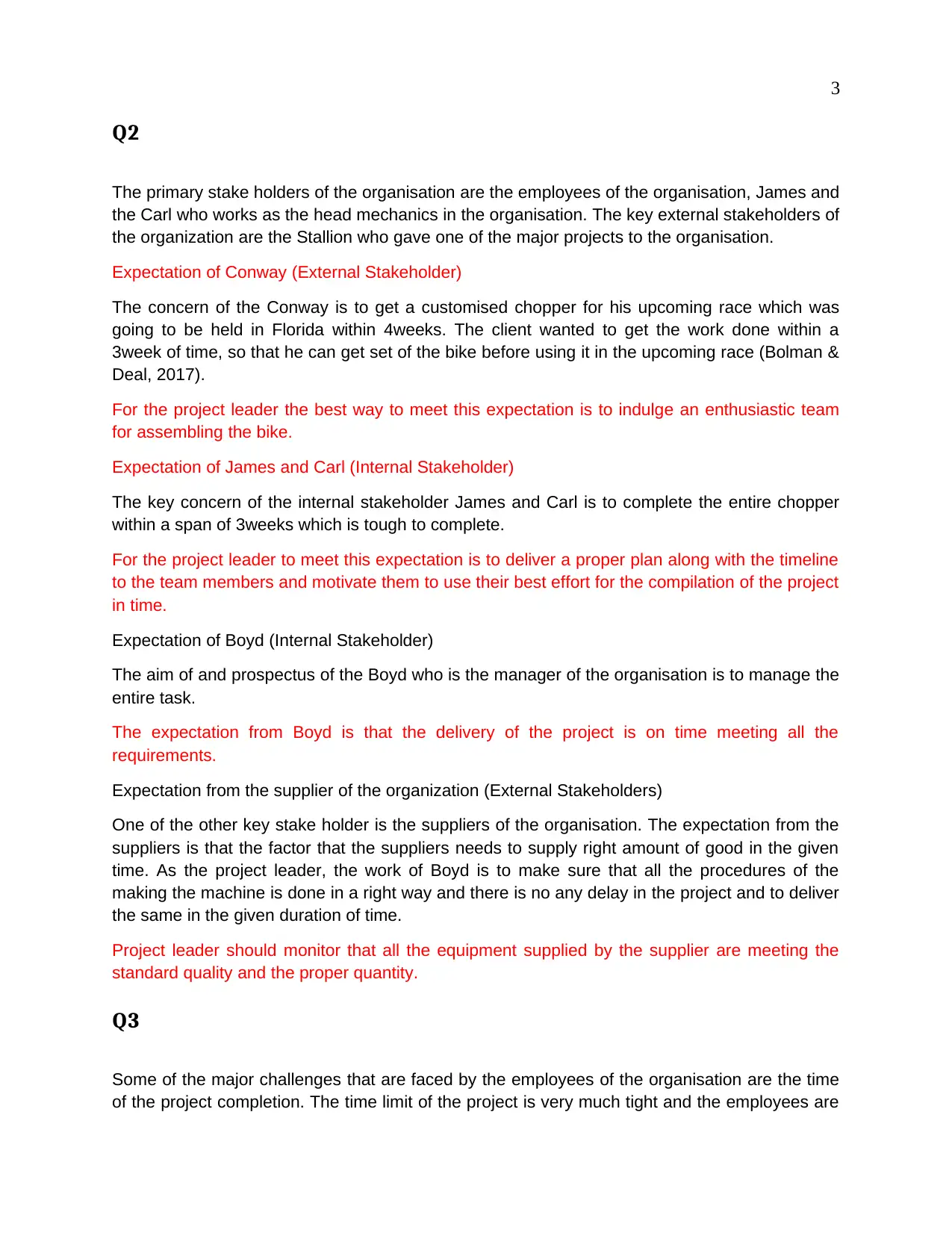
3
Q2
The primary stake holders of the organisation are the employees of the organisation, James and
the Carl who works as the head mechanics in the organisation. The key external stakeholders of
the organization are the Stallion who gave one of the major projects to the organisation.
Expectation of Conway (External Stakeholder)
The concern of the Conway is to get a customised chopper for his upcoming race which was
going to be held in Florida within 4weeks. The client wanted to get the work done within a
3week of time, so that he can get set of the bike before using it in the upcoming race (Bolman &
Deal, 2017).
For the project leader the best way to meet this expectation is to indulge an enthusiastic team
for assembling the bike.
Expectation of James and Carl (Internal Stakeholder)
The key concern of the internal stakeholder James and Carl is to complete the entire chopper
within a span of 3weeks which is tough to complete.
For the project leader to meet this expectation is to deliver a proper plan along with the timeline
to the team members and motivate them to use their best effort for the compilation of the project
in time.
Expectation of Boyd (Internal Stakeholder)
The aim of and prospectus of the Boyd who is the manager of the organisation is to manage the
entire task.
The expectation from Boyd is that the delivery of the project is on time meeting all the
requirements.
Expectation from the supplier of the organization (External Stakeholders)
One of the other key stake holder is the suppliers of the organisation. The expectation from the
suppliers is that the factor that the suppliers needs to supply right amount of good in the given
time. As the project leader, the work of Boyd is to make sure that all the procedures of the
making the machine is done in a right way and there is no any delay in the project and to deliver
the same in the given duration of time.
Project leader should monitor that all the equipment supplied by the supplier are meeting the
standard quality and the proper quantity.
Q3
Some of the major challenges that are faced by the employees of the organisation are the time
of the project completion. The time limit of the project is very much tight and the employees are
Q2
The primary stake holders of the organisation are the employees of the organisation, James and
the Carl who works as the head mechanics in the organisation. The key external stakeholders of
the organization are the Stallion who gave one of the major projects to the organisation.
Expectation of Conway (External Stakeholder)
The concern of the Conway is to get a customised chopper for his upcoming race which was
going to be held in Florida within 4weeks. The client wanted to get the work done within a
3week of time, so that he can get set of the bike before using it in the upcoming race (Bolman &
Deal, 2017).
For the project leader the best way to meet this expectation is to indulge an enthusiastic team
for assembling the bike.
Expectation of James and Carl (Internal Stakeholder)
The key concern of the internal stakeholder James and Carl is to complete the entire chopper
within a span of 3weeks which is tough to complete.
For the project leader to meet this expectation is to deliver a proper plan along with the timeline
to the team members and motivate them to use their best effort for the compilation of the project
in time.
Expectation of Boyd (Internal Stakeholder)
The aim of and prospectus of the Boyd who is the manager of the organisation is to manage the
entire task.
The expectation from Boyd is that the delivery of the project is on time meeting all the
requirements.
Expectation from the supplier of the organization (External Stakeholders)
One of the other key stake holder is the suppliers of the organisation. The expectation from the
suppliers is that the factor that the suppliers needs to supply right amount of good in the given
time. As the project leader, the work of Boyd is to make sure that all the procedures of the
making the machine is done in a right way and there is no any delay in the project and to deliver
the same in the given duration of time.
Project leader should monitor that all the equipment supplied by the supplier are meeting the
standard quality and the proper quantity.
Q3
Some of the major challenges that are faced by the employees of the organisation are the time
of the project completion. The time limit of the project is very much tight and the employees are
⊘ This is a preview!⊘
Do you want full access?
Subscribe today to unlock all pages.

Trusted by 1+ million students worldwide
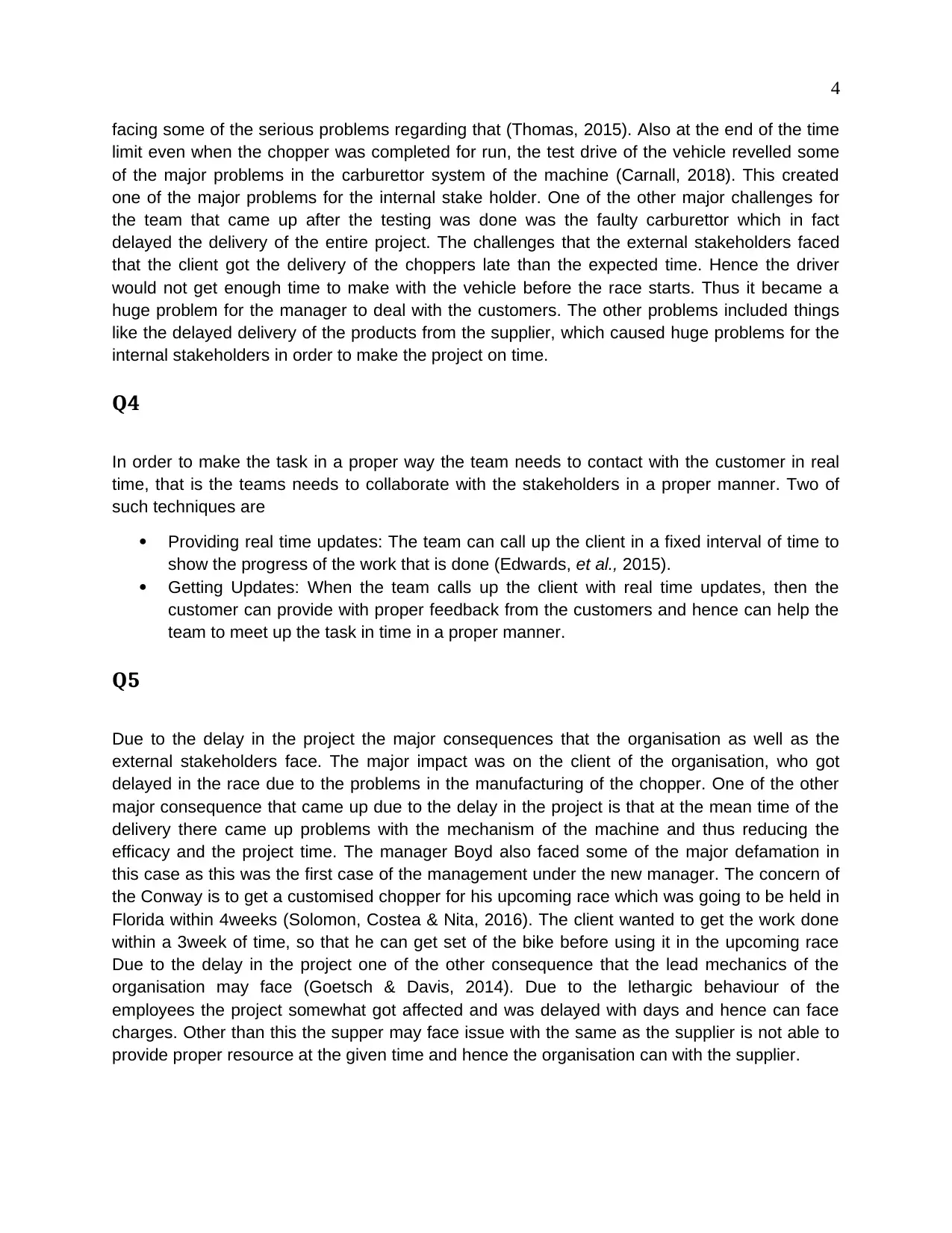
4
facing some of the serious problems regarding that (Thomas, 2015). Also at the end of the time
limit even when the chopper was completed for run, the test drive of the vehicle revelled some
of the major problems in the carburettor system of the machine (Carnall, 2018). This created
one of the major problems for the internal stake holder. One of the other major challenges for
the team that came up after the testing was done was the faulty carburettor which in fact
delayed the delivery of the entire project. The challenges that the external stakeholders faced
that the client got the delivery of the choppers late than the expected time. Hence the driver
would not get enough time to make with the vehicle before the race starts. Thus it became a
huge problem for the manager to deal with the customers. The other problems included things
like the delayed delivery of the products from the supplier, which caused huge problems for the
internal stakeholders in order to make the project on time.
Q4
In order to make the task in a proper way the team needs to contact with the customer in real
time, that is the teams needs to collaborate with the stakeholders in a proper manner. Two of
such techniques are
Providing real time updates: The team can call up the client in a fixed interval of time to
show the progress of the work that is done (Edwards, et al., 2015).
Getting Updates: When the team calls up the client with real time updates, then the
customer can provide with proper feedback from the customers and hence can help the
team to meet up the task in time in a proper manner.
Q5
Due to the delay in the project the major consequences that the organisation as well as the
external stakeholders face. The major impact was on the client of the organisation, who got
delayed in the race due to the problems in the manufacturing of the chopper. One of the other
major consequence that came up due to the delay in the project is that at the mean time of the
delivery there came up problems with the mechanism of the machine and thus reducing the
efficacy and the project time. The manager Boyd also faced some of the major defamation in
this case as this was the first case of the management under the new manager. The concern of
the Conway is to get a customised chopper for his upcoming race which was going to be held in
Florida within 4weeks (Solomon, Costea & Nita, 2016). The client wanted to get the work done
within a 3week of time, so that he can get set of the bike before using it in the upcoming race
Due to the delay in the project one of the other consequence that the lead mechanics of the
organisation may face (Goetsch & Davis, 2014). Due to the lethargic behaviour of the
employees the project somewhat got affected and was delayed with days and hence can face
charges. Other than this the supper may face issue with the same as the supplier is not able to
provide proper resource at the given time and hence the organisation can with the supplier.
facing some of the serious problems regarding that (Thomas, 2015). Also at the end of the time
limit even when the chopper was completed for run, the test drive of the vehicle revelled some
of the major problems in the carburettor system of the machine (Carnall, 2018). This created
one of the major problems for the internal stake holder. One of the other major challenges for
the team that came up after the testing was done was the faulty carburettor which in fact
delayed the delivery of the entire project. The challenges that the external stakeholders faced
that the client got the delivery of the choppers late than the expected time. Hence the driver
would not get enough time to make with the vehicle before the race starts. Thus it became a
huge problem for the manager to deal with the customers. The other problems included things
like the delayed delivery of the products from the supplier, which caused huge problems for the
internal stakeholders in order to make the project on time.
Q4
In order to make the task in a proper way the team needs to contact with the customer in real
time, that is the teams needs to collaborate with the stakeholders in a proper manner. Two of
such techniques are
Providing real time updates: The team can call up the client in a fixed interval of time to
show the progress of the work that is done (Edwards, et al., 2015).
Getting Updates: When the team calls up the client with real time updates, then the
customer can provide with proper feedback from the customers and hence can help the
team to meet up the task in time in a proper manner.
Q5
Due to the delay in the project the major consequences that the organisation as well as the
external stakeholders face. The major impact was on the client of the organisation, who got
delayed in the race due to the problems in the manufacturing of the chopper. One of the other
major consequence that came up due to the delay in the project is that at the mean time of the
delivery there came up problems with the mechanism of the machine and thus reducing the
efficacy and the project time. The manager Boyd also faced some of the major defamation in
this case as this was the first case of the management under the new manager. The concern of
the Conway is to get a customised chopper for his upcoming race which was going to be held in
Florida within 4weeks (Solomon, Costea & Nita, 2016). The client wanted to get the work done
within a 3week of time, so that he can get set of the bike before using it in the upcoming race
Due to the delay in the project one of the other consequence that the lead mechanics of the
organisation may face (Goetsch & Davis, 2014). Due to the lethargic behaviour of the
employees the project somewhat got affected and was delayed with days and hence can face
charges. Other than this the supper may face issue with the same as the supplier is not able to
provide proper resource at the given time and hence the organisation can with the supplier.
Paraphrase This Document
Need a fresh take? Get an instant paraphrase of this document with our AI Paraphraser
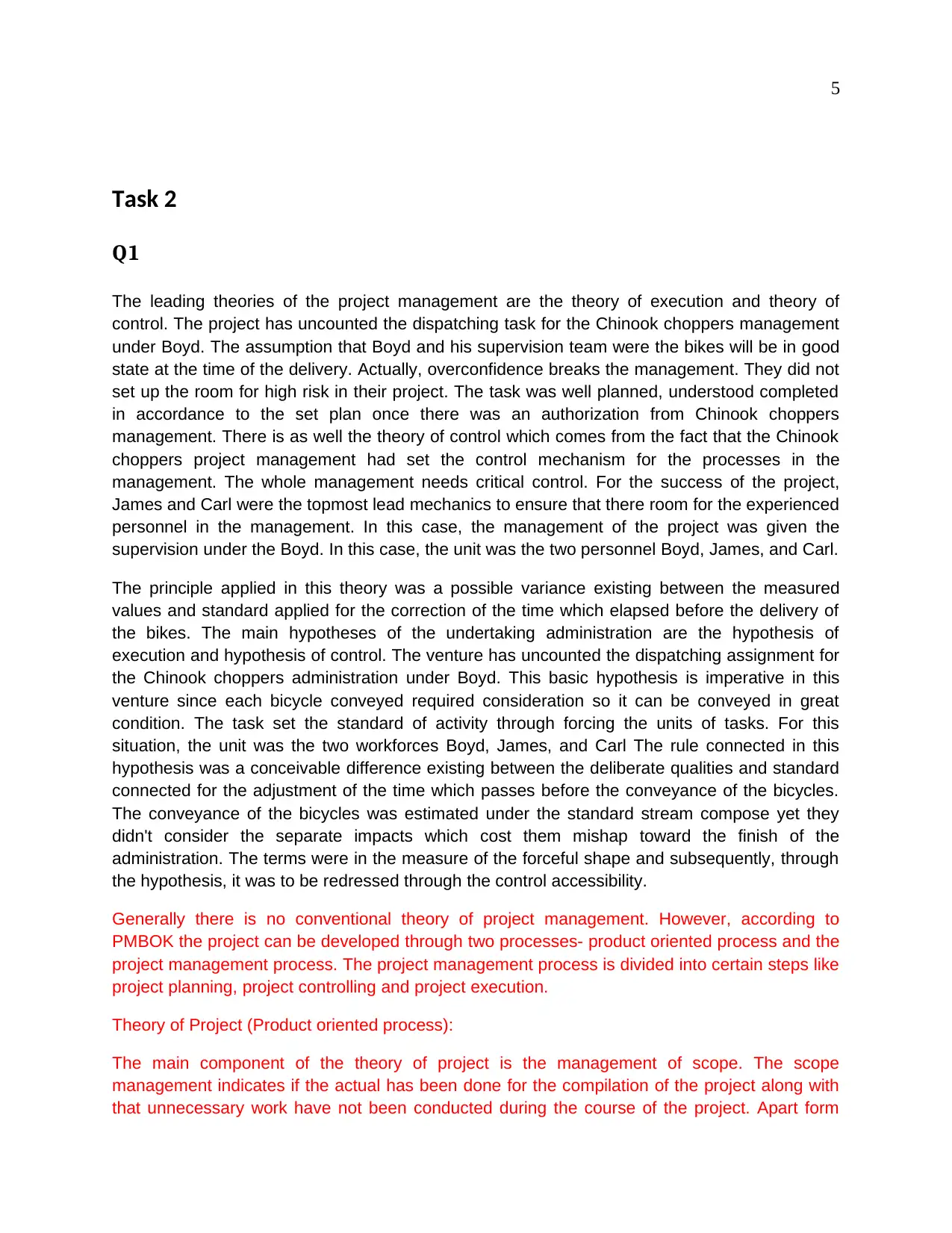
5
Task 2
Q1
The leading theories of the project management are the theory of execution and theory of
control. The project has uncounted the dispatching task for the Chinook choppers management
under Boyd. The assumption that Boyd and his supervision team were the bikes will be in good
state at the time of the delivery. Actually, overconfidence breaks the management. They did not
set up the room for high risk in their project. The task was well planned, understood completed
in accordance to the set plan once there was an authorization from Chinook choppers
management. There is as well the theory of control which comes from the fact that the Chinook
choppers project management had set the control mechanism for the processes in the
management. The whole management needs critical control. For the success of the project,
James and Carl were the topmost lead mechanics to ensure that there room for the experienced
personnel in the management. In this case, the management of the project was given the
supervision under the Boyd. In this case, the unit was the two personnel Boyd, James, and Carl.
The principle applied in this theory was a possible variance existing between the measured
values and standard applied for the correction of the time which elapsed before the delivery of
the bikes. The main hypotheses of the undertaking administration are the hypothesis of
execution and hypothesis of control. The venture has uncounted the dispatching assignment for
the Chinook choppers administration under Boyd. This basic hypothesis is imperative in this
venture since each bicycle conveyed required consideration so it can be conveyed in great
condition. The task set the standard of activity through forcing the units of tasks. For this
situation, the unit was the two workforces Boyd, James, and Carl The rule connected in this
hypothesis was a conceivable difference existing between the deliberate qualities and standard
connected for the adjustment of the time which passes before the conveyance of the bicycles.
The conveyance of the bicycles was estimated under the standard stream compose yet they
didn't consider the separate impacts which cost them mishap toward the finish of the
administration. The terms were in the measure of the forceful shape and subsequently, through
the hypothesis, it was to be redressed through the control accessibility.
Generally there is no conventional theory of project management. However, according to
PMBOK the project can be developed through two processes- product oriented process and the
project management process. The project management process is divided into certain steps like
project planning, project controlling and project execution.
Theory of Project (Product oriented process):
The main component of the theory of project is the management of scope. The scope
management indicates if the actual has been done for the compilation of the project along with
that unnecessary work have not been conducted during the course of the project. Apart form
Task 2
Q1
The leading theories of the project management are the theory of execution and theory of
control. The project has uncounted the dispatching task for the Chinook choppers management
under Boyd. The assumption that Boyd and his supervision team were the bikes will be in good
state at the time of the delivery. Actually, overconfidence breaks the management. They did not
set up the room for high risk in their project. The task was well planned, understood completed
in accordance to the set plan once there was an authorization from Chinook choppers
management. There is as well the theory of control which comes from the fact that the Chinook
choppers project management had set the control mechanism for the processes in the
management. The whole management needs critical control. For the success of the project,
James and Carl were the topmost lead mechanics to ensure that there room for the experienced
personnel in the management. In this case, the management of the project was given the
supervision under the Boyd. In this case, the unit was the two personnel Boyd, James, and Carl.
The principle applied in this theory was a possible variance existing between the measured
values and standard applied for the correction of the time which elapsed before the delivery of
the bikes. The main hypotheses of the undertaking administration are the hypothesis of
execution and hypothesis of control. The venture has uncounted the dispatching assignment for
the Chinook choppers administration under Boyd. This basic hypothesis is imperative in this
venture since each bicycle conveyed required consideration so it can be conveyed in great
condition. The task set the standard of activity through forcing the units of tasks. For this
situation, the unit was the two workforces Boyd, James, and Carl The rule connected in this
hypothesis was a conceivable difference existing between the deliberate qualities and standard
connected for the adjustment of the time which passes before the conveyance of the bicycles.
The conveyance of the bicycles was estimated under the standard stream compose yet they
didn't consider the separate impacts which cost them mishap toward the finish of the
administration. The terms were in the measure of the forceful shape and subsequently, through
the hypothesis, it was to be redressed through the control accessibility.
Generally there is no conventional theory of project management. However, according to
PMBOK the project can be developed through two processes- product oriented process and the
project management process. The project management process is divided into certain steps like
project planning, project controlling and project execution.
Theory of Project (Product oriented process):
The main component of the theory of project is the management of scope. The scope
management indicates if the actual has been done for the compilation of the project along with
that unnecessary work have not been conducted during the course of the project. Apart form
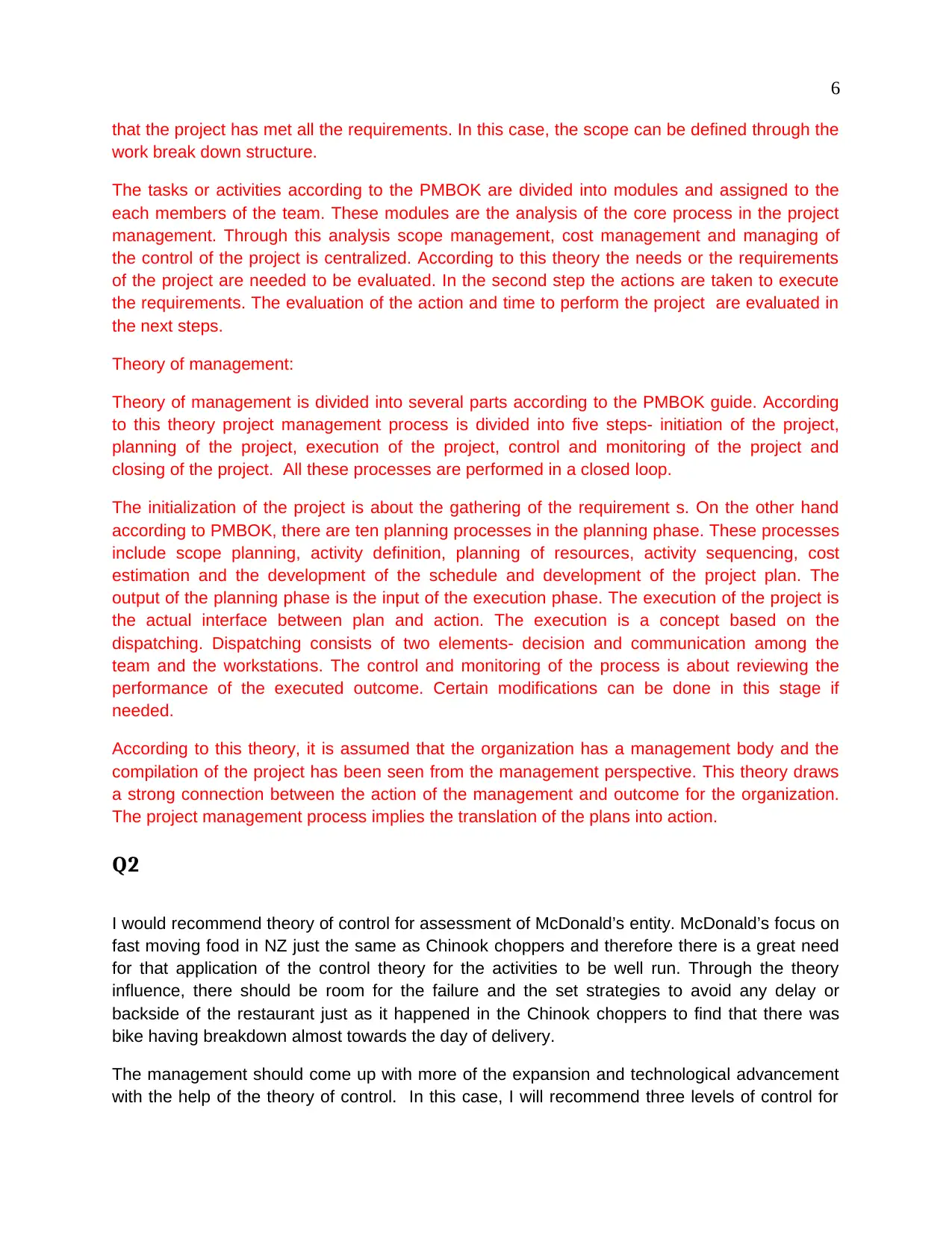
6
that the project has met all the requirements. In this case, the scope can be defined through the
work break down structure.
The tasks or activities according to the PMBOK are divided into modules and assigned to the
each members of the team. These modules are the analysis of the core process in the project
management. Through this analysis scope management, cost management and managing of
the control of the project is centralized. According to this theory the needs or the requirements
of the project are needed to be evaluated. In the second step the actions are taken to execute
the requirements. The evaluation of the action and time to perform the project are evaluated in
the next steps.
Theory of management:
Theory of management is divided into several parts according to the PMBOK guide. According
to this theory project management process is divided into five steps- initiation of the project,
planning of the project, execution of the project, control and monitoring of the project and
closing of the project. All these processes are performed in a closed loop.
The initialization of the project is about the gathering of the requirement s. On the other hand
according to PMBOK, there are ten planning processes in the planning phase. These processes
include scope planning, activity definition, planning of resources, activity sequencing, cost
estimation and the development of the schedule and development of the project plan. The
output of the planning phase is the input of the execution phase. The execution of the project is
the actual interface between plan and action. The execution is a concept based on the
dispatching. Dispatching consists of two elements- decision and communication among the
team and the workstations. The control and monitoring of the process is about reviewing the
performance of the executed outcome. Certain modifications can be done in this stage if
needed.
According to this theory, it is assumed that the organization has a management body and the
compilation of the project has been seen from the management perspective. This theory draws
a strong connection between the action of the management and outcome for the organization.
The project management process implies the translation of the plans into action.
Q2
I would recommend theory of control for assessment of McDonald’s entity. McDonald’s focus on
fast moving food in NZ just the same as Chinook choppers and therefore there is a great need
for that application of the control theory for the activities to be well run. Through the theory
influence, there should be room for the failure and the set strategies to avoid any delay or
backside of the restaurant just as it happened in the Chinook choppers to find that there was
bike having breakdown almost towards the day of delivery.
The management should come up with more of the expansion and technological advancement
with the help of the theory of control. In this case, I will recommend three levels of control for
that the project has met all the requirements. In this case, the scope can be defined through the
work break down structure.
The tasks or activities according to the PMBOK are divided into modules and assigned to the
each members of the team. These modules are the analysis of the core process in the project
management. Through this analysis scope management, cost management and managing of
the control of the project is centralized. According to this theory the needs or the requirements
of the project are needed to be evaluated. In the second step the actions are taken to execute
the requirements. The evaluation of the action and time to perform the project are evaluated in
the next steps.
Theory of management:
Theory of management is divided into several parts according to the PMBOK guide. According
to this theory project management process is divided into five steps- initiation of the project,
planning of the project, execution of the project, control and monitoring of the project and
closing of the project. All these processes are performed in a closed loop.
The initialization of the project is about the gathering of the requirement s. On the other hand
according to PMBOK, there are ten planning processes in the planning phase. These processes
include scope planning, activity definition, planning of resources, activity sequencing, cost
estimation and the development of the schedule and development of the project plan. The
output of the planning phase is the input of the execution phase. The execution of the project is
the actual interface between plan and action. The execution is a concept based on the
dispatching. Dispatching consists of two elements- decision and communication among the
team and the workstations. The control and monitoring of the process is about reviewing the
performance of the executed outcome. Certain modifications can be done in this stage if
needed.
According to this theory, it is assumed that the organization has a management body and the
compilation of the project has been seen from the management perspective. This theory draws
a strong connection between the action of the management and outcome for the organization.
The project management process implies the translation of the plans into action.
Q2
I would recommend theory of control for assessment of McDonald’s entity. McDonald’s focus on
fast moving food in NZ just the same as Chinook choppers and therefore there is a great need
for that application of the control theory for the activities to be well run. Through the theory
influence, there should be room for the failure and the set strategies to avoid any delay or
backside of the restaurant just as it happened in the Chinook choppers to find that there was
bike having breakdown almost towards the day of delivery.
The management should come up with more of the expansion and technological advancement
with the help of the theory of control. In this case, I will recommend three levels of control for
⊘ This is a preview!⊘
Do you want full access?
Subscribe today to unlock all pages.

Trusted by 1+ million students worldwide
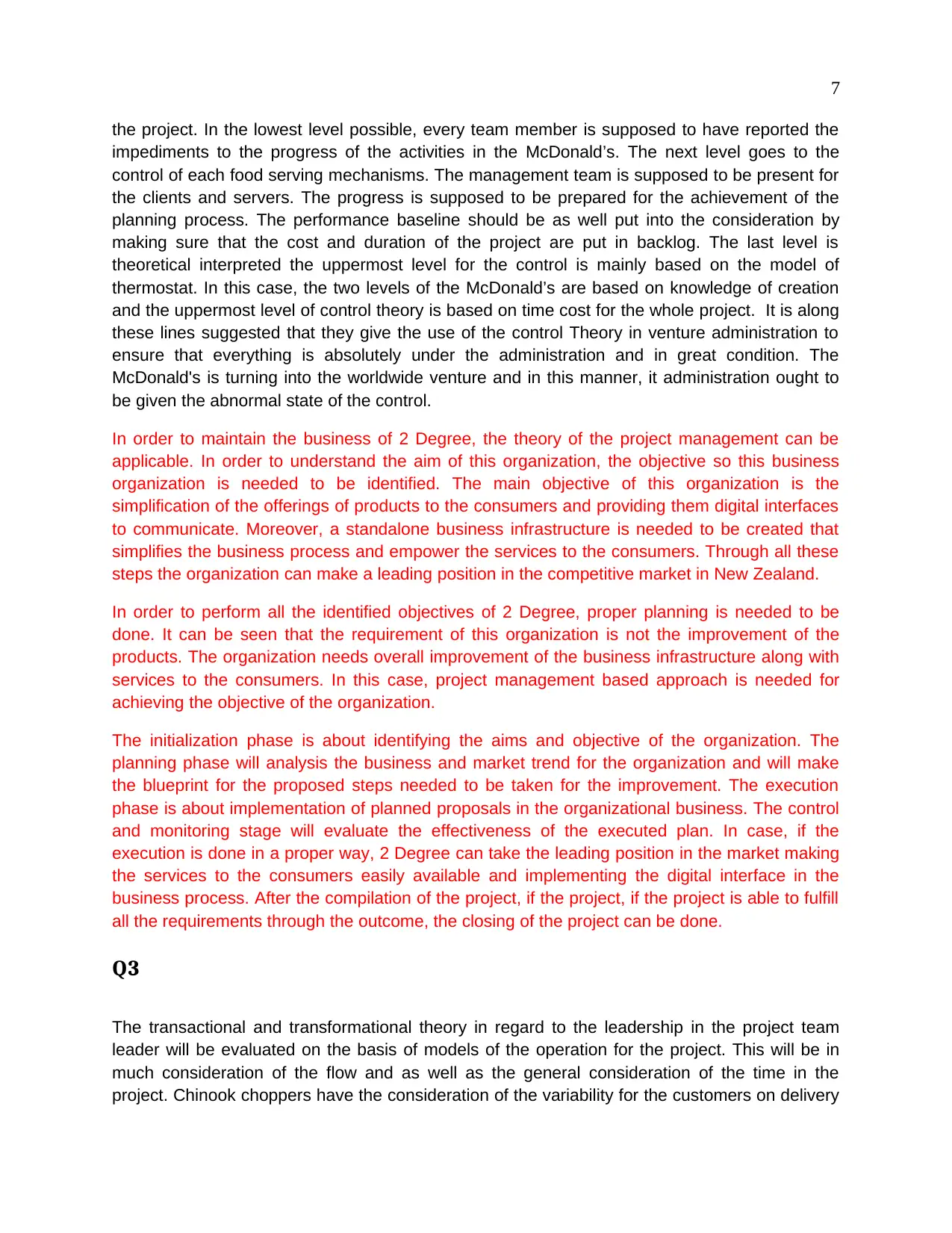
7
the project. In the lowest level possible, every team member is supposed to have reported the
impediments to the progress of the activities in the McDonald’s. The next level goes to the
control of each food serving mechanisms. The management team is supposed to be present for
the clients and servers. The progress is supposed to be prepared for the achievement of the
planning process. The performance baseline should be as well put into the consideration by
making sure that the cost and duration of the project are put in backlog. The last level is
theoretical interpreted the uppermost level for the control is mainly based on the model of
thermostat. In this case, the two levels of the McDonald’s are based on knowledge of creation
and the uppermost level of control theory is based on time cost for the whole project. It is along
these lines suggested that they give the use of the control Theory in venture administration to
ensure that everything is absolutely under the administration and in great condition. The
McDonald's is turning into the worldwide venture and in this manner, it administration ought to
be given the abnormal state of the control.
In order to maintain the business of 2 Degree, the theory of the project management can be
applicable. In order to understand the aim of this organization, the objective so this business
organization is needed to be identified. The main objective of this organization is the
simplification of the offerings of products to the consumers and providing them digital interfaces
to communicate. Moreover, a standalone business infrastructure is needed to be created that
simplifies the business process and empower the services to the consumers. Through all these
steps the organization can make a leading position in the competitive market in New Zealand.
In order to perform all the identified objectives of 2 Degree, proper planning is needed to be
done. It can be seen that the requirement of this organization is not the improvement of the
products. The organization needs overall improvement of the business infrastructure along with
services to the consumers. In this case, project management based approach is needed for
achieving the objective of the organization.
The initialization phase is about identifying the aims and objective of the organization. The
planning phase will analysis the business and market trend for the organization and will make
the blueprint for the proposed steps needed to be taken for the improvement. The execution
phase is about implementation of planned proposals in the organizational business. The control
and monitoring stage will evaluate the effectiveness of the executed plan. In case, if the
execution is done in a proper way, 2 Degree can take the leading position in the market making
the services to the consumers easily available and implementing the digital interface in the
business process. After the compilation of the project, if the project, if the project is able to fulfill
all the requirements through the outcome, the closing of the project can be done.
Q3
The transactional and transformational theory in regard to the leadership in the project team
leader will be evaluated on the basis of models of the operation for the project. This will be in
much consideration of the flow and as well as the general consideration of the time in the
project. Chinook choppers have the consideration of the variability for the customers on delivery
the project. In the lowest level possible, every team member is supposed to have reported the
impediments to the progress of the activities in the McDonald’s. The next level goes to the
control of each food serving mechanisms. The management team is supposed to be present for
the clients and servers. The progress is supposed to be prepared for the achievement of the
planning process. The performance baseline should be as well put into the consideration by
making sure that the cost and duration of the project are put in backlog. The last level is
theoretical interpreted the uppermost level for the control is mainly based on the model of
thermostat. In this case, the two levels of the McDonald’s are based on knowledge of creation
and the uppermost level of control theory is based on time cost for the whole project. It is along
these lines suggested that they give the use of the control Theory in venture administration to
ensure that everything is absolutely under the administration and in great condition. The
McDonald's is turning into the worldwide venture and in this manner, it administration ought to
be given the abnormal state of the control.
In order to maintain the business of 2 Degree, the theory of the project management can be
applicable. In order to understand the aim of this organization, the objective so this business
organization is needed to be identified. The main objective of this organization is the
simplification of the offerings of products to the consumers and providing them digital interfaces
to communicate. Moreover, a standalone business infrastructure is needed to be created that
simplifies the business process and empower the services to the consumers. Through all these
steps the organization can make a leading position in the competitive market in New Zealand.
In order to perform all the identified objectives of 2 Degree, proper planning is needed to be
done. It can be seen that the requirement of this organization is not the improvement of the
products. The organization needs overall improvement of the business infrastructure along with
services to the consumers. In this case, project management based approach is needed for
achieving the objective of the organization.
The initialization phase is about identifying the aims and objective of the organization. The
planning phase will analysis the business and market trend for the organization and will make
the blueprint for the proposed steps needed to be taken for the improvement. The execution
phase is about implementation of planned proposals in the organizational business. The control
and monitoring stage will evaluate the effectiveness of the executed plan. In case, if the
execution is done in a proper way, 2 Degree can take the leading position in the market making
the services to the consumers easily available and implementing the digital interface in the
business process. After the compilation of the project, if the project, if the project is able to fulfill
all the requirements through the outcome, the closing of the project can be done.
Q3
The transactional and transformational theory in regard to the leadership in the project team
leader will be evaluated on the basis of models of the operation for the project. This will be in
much consideration of the flow and as well as the general consideration of the time in the
project. Chinook choppers have the consideration of the variability for the customers on delivery
Paraphrase This Document
Need a fresh take? Get an instant paraphrase of this document with our AI Paraphraser
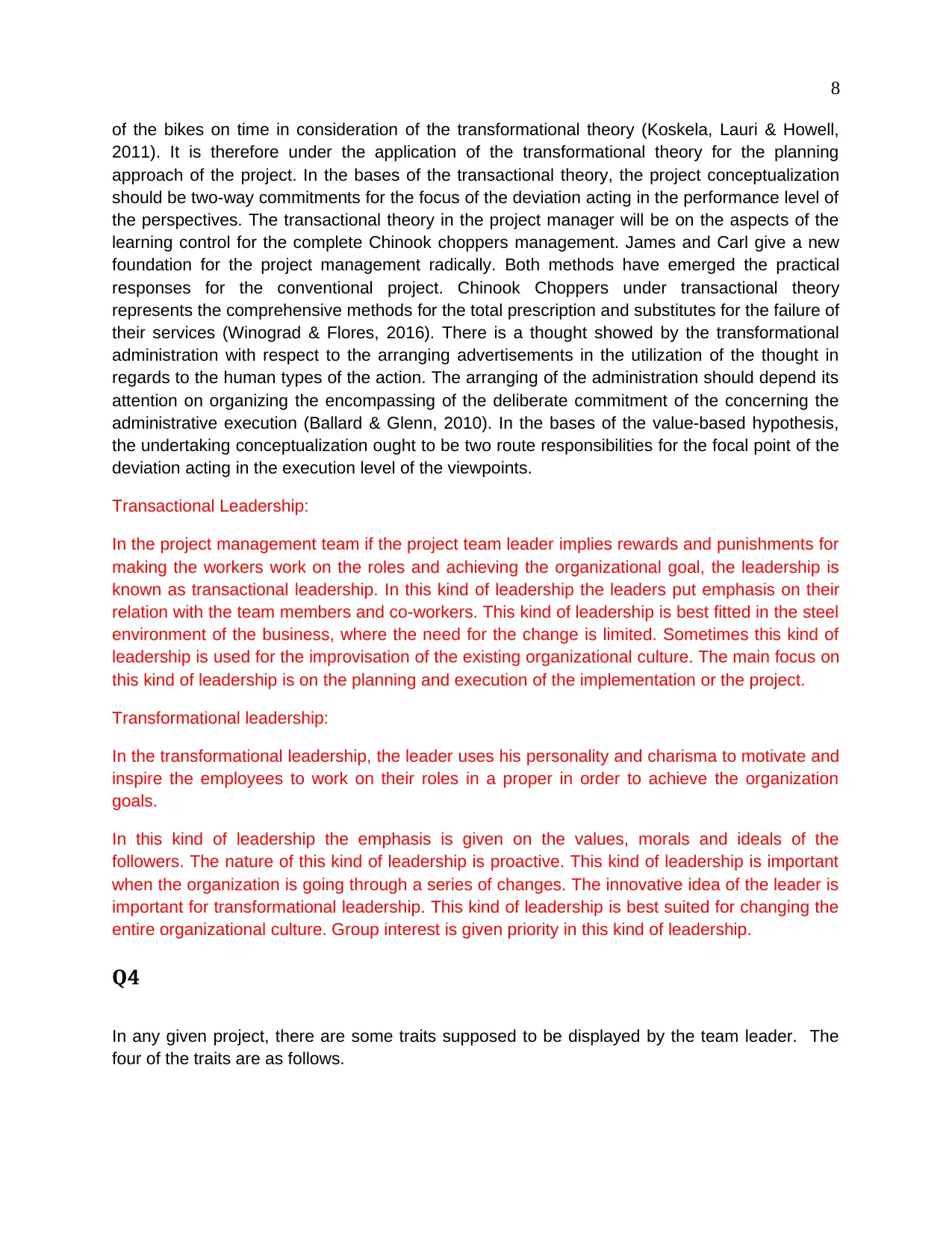
8
of the bikes on time in consideration of the transformational theory (Koskela, Lauri & Howell,
2011). It is therefore under the application of the transformational theory for the planning
approach of the project. In the bases of the transactional theory, the project conceptualization
should be two-way commitments for the focus of the deviation acting in the performance level of
the perspectives. The transactional theory in the project manager will be on the aspects of the
learning control for the complete Chinook choppers management. James and Carl give a new
foundation for the project management radically. Both methods have emerged the practical
responses for the conventional project. Chinook Choppers under transactional theory
represents the comprehensive methods for the total prescription and substitutes for the failure of
their services (Winograd & Flores, 2016). There is a thought showed by the transformational
administration with respect to the arranging advertisements in the utilization of the thought in
regards to the human types of the action. The arranging of the administration should depend its
attention on organizing the encompassing of the deliberate commitment of the concerning the
administrative execution (Ballard & Glenn, 2010). In the bases of the value-based hypothesis,
the undertaking conceptualization ought to be two route responsibilities for the focal point of the
deviation acting in the execution level of the viewpoints.
Transactional Leadership:
In the project management team if the project team leader implies rewards and punishments for
making the workers work on the roles and achieving the organizational goal, the leadership is
known as transactional leadership. In this kind of leadership the leaders put emphasis on their
relation with the team members and co-workers. This kind of leadership is best fitted in the steel
environment of the business, where the need for the change is limited. Sometimes this kind of
leadership is used for the improvisation of the existing organizational culture. The main focus on
this kind of leadership is on the planning and execution of the implementation or the project.
Transformational leadership:
In the transformational leadership, the leader uses his personality and charisma to motivate and
inspire the employees to work on their roles in a proper in order to achieve the organization
goals.
In this kind of leadership the emphasis is given on the values, morals and ideals of the
followers. The nature of this kind of leadership is proactive. This kind of leadership is important
when the organization is going through a series of changes. The innovative idea of the leader is
important for transformational leadership. This kind of leadership is best suited for changing the
entire organizational culture. Group interest is given priority in this kind of leadership.
Q4
In any given project, there are some traits supposed to be displayed by the team leader. The
four of the traits are as follows.
of the bikes on time in consideration of the transformational theory (Koskela, Lauri & Howell,
2011). It is therefore under the application of the transformational theory for the planning
approach of the project. In the bases of the transactional theory, the project conceptualization
should be two-way commitments for the focus of the deviation acting in the performance level of
the perspectives. The transactional theory in the project manager will be on the aspects of the
learning control for the complete Chinook choppers management. James and Carl give a new
foundation for the project management radically. Both methods have emerged the practical
responses for the conventional project. Chinook Choppers under transactional theory
represents the comprehensive methods for the total prescription and substitutes for the failure of
their services (Winograd & Flores, 2016). There is a thought showed by the transformational
administration with respect to the arranging advertisements in the utilization of the thought in
regards to the human types of the action. The arranging of the administration should depend its
attention on organizing the encompassing of the deliberate commitment of the concerning the
administrative execution (Ballard & Glenn, 2010). In the bases of the value-based hypothesis,
the undertaking conceptualization ought to be two route responsibilities for the focal point of the
deviation acting in the execution level of the viewpoints.
Transactional Leadership:
In the project management team if the project team leader implies rewards and punishments for
making the workers work on the roles and achieving the organizational goal, the leadership is
known as transactional leadership. In this kind of leadership the leaders put emphasis on their
relation with the team members and co-workers. This kind of leadership is best fitted in the steel
environment of the business, where the need for the change is limited. Sometimes this kind of
leadership is used for the improvisation of the existing organizational culture. The main focus on
this kind of leadership is on the planning and execution of the implementation or the project.
Transformational leadership:
In the transformational leadership, the leader uses his personality and charisma to motivate and
inspire the employees to work on their roles in a proper in order to achieve the organization
goals.
In this kind of leadership the emphasis is given on the values, morals and ideals of the
followers. The nature of this kind of leadership is proactive. This kind of leadership is important
when the organization is going through a series of changes. The innovative idea of the leader is
important for transformational leadership. This kind of leadership is best suited for changing the
entire organizational culture. Group interest is given priority in this kind of leadership.
Q4
In any given project, there are some traits supposed to be displayed by the team leader. The
four of the traits are as follows.
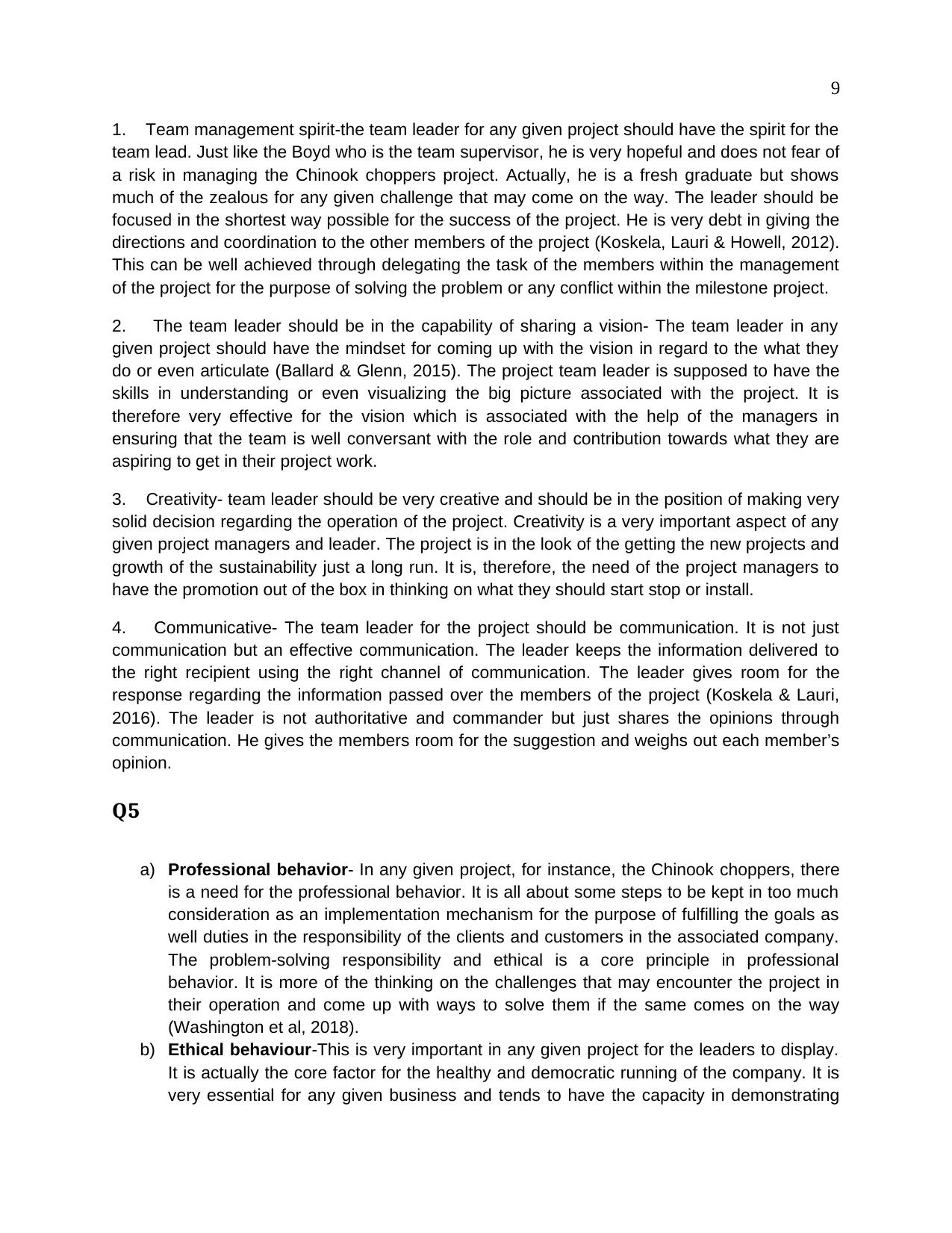
9
1. Team management spirit-the team leader for any given project should have the spirit for the
team lead. Just like the Boyd who is the team supervisor, he is very hopeful and does not fear of
a risk in managing the Chinook choppers project. Actually, he is a fresh graduate but shows
much of the zealous for any given challenge that may come on the way. The leader should be
focused in the shortest way possible for the success of the project. He is very debt in giving the
directions and coordination to the other members of the project (Koskela, Lauri & Howell, 2012).
This can be well achieved through delegating the task of the members within the management
of the project for the purpose of solving the problem or any conflict within the milestone project.
2. The team leader should be in the capability of sharing a vision- The team leader in any
given project should have the mindset for coming up with the vision in regard to the what they
do or even articulate (Ballard & Glenn, 2015). The project team leader is supposed to have the
skills in understanding or even visualizing the big picture associated with the project. It is
therefore very effective for the vision which is associated with the help of the managers in
ensuring that the team is well conversant with the role and contribution towards what they are
aspiring to get in their project work.
3. Creativity- team leader should be very creative and should be in the position of making very
solid decision regarding the operation of the project. Creativity is a very important aspect of any
given project managers and leader. The project is in the look of the getting the new projects and
growth of the sustainability just a long run. It is, therefore, the need of the project managers to
have the promotion out of the box in thinking on what they should start stop or install.
4. Communicative- The team leader for the project should be communication. It is not just
communication but an effective communication. The leader keeps the information delivered to
the right recipient using the right channel of communication. The leader gives room for the
response regarding the information passed over the members of the project (Koskela & Lauri,
2016). The leader is not authoritative and commander but just shares the opinions through
communication. He gives the members room for the suggestion and weighs out each member’s
opinion.
Q5
a) Professional behavior- In any given project, for instance, the Chinook choppers, there
is a need for the professional behavior. It is all about some steps to be kept in too much
consideration as an implementation mechanism for the purpose of fulfilling the goals as
well duties in the responsibility of the clients and customers in the associated company.
The problem-solving responsibility and ethical is a core principle in professional
behavior. It is more of the thinking on the challenges that may encounter the project in
their operation and come up with ways to solve them if the same comes on the way
(Washington et al, 2018).
b) Ethical behaviour-This is very important in any given project for the leaders to display.
It is actually the core factor for the healthy and democratic running of the company. It is
very essential for any given business and tends to have the capacity in demonstrating
1. Team management spirit-the team leader for any given project should have the spirit for the
team lead. Just like the Boyd who is the team supervisor, he is very hopeful and does not fear of
a risk in managing the Chinook choppers project. Actually, he is a fresh graduate but shows
much of the zealous for any given challenge that may come on the way. The leader should be
focused in the shortest way possible for the success of the project. He is very debt in giving the
directions and coordination to the other members of the project (Koskela, Lauri & Howell, 2012).
This can be well achieved through delegating the task of the members within the management
of the project for the purpose of solving the problem or any conflict within the milestone project.
2. The team leader should be in the capability of sharing a vision- The team leader in any
given project should have the mindset for coming up with the vision in regard to the what they
do or even articulate (Ballard & Glenn, 2015). The project team leader is supposed to have the
skills in understanding or even visualizing the big picture associated with the project. It is
therefore very effective for the vision which is associated with the help of the managers in
ensuring that the team is well conversant with the role and contribution towards what they are
aspiring to get in their project work.
3. Creativity- team leader should be very creative and should be in the position of making very
solid decision regarding the operation of the project. Creativity is a very important aspect of any
given project managers and leader. The project is in the look of the getting the new projects and
growth of the sustainability just a long run. It is, therefore, the need of the project managers to
have the promotion out of the box in thinking on what they should start stop or install.
4. Communicative- The team leader for the project should be communication. It is not just
communication but an effective communication. The leader keeps the information delivered to
the right recipient using the right channel of communication. The leader gives room for the
response regarding the information passed over the members of the project (Koskela & Lauri,
2016). The leader is not authoritative and commander but just shares the opinions through
communication. He gives the members room for the suggestion and weighs out each member’s
opinion.
Q5
a) Professional behavior- In any given project, for instance, the Chinook choppers, there
is a need for the professional behavior. It is all about some steps to be kept in too much
consideration as an implementation mechanism for the purpose of fulfilling the goals as
well duties in the responsibility of the clients and customers in the associated company.
The problem-solving responsibility and ethical is a core principle in professional
behavior. It is more of the thinking on the challenges that may encounter the project in
their operation and come up with ways to solve them if the same comes on the way
(Washington et al, 2018).
b) Ethical behaviour-This is very important in any given project for the leaders to display.
It is actually the core factor for the healthy and democratic running of the company. It is
very essential for any given business and tends to have the capacity in demonstrating
⊘ This is a preview!⊘
Do you want full access?
Subscribe today to unlock all pages.

Trusted by 1+ million students worldwide
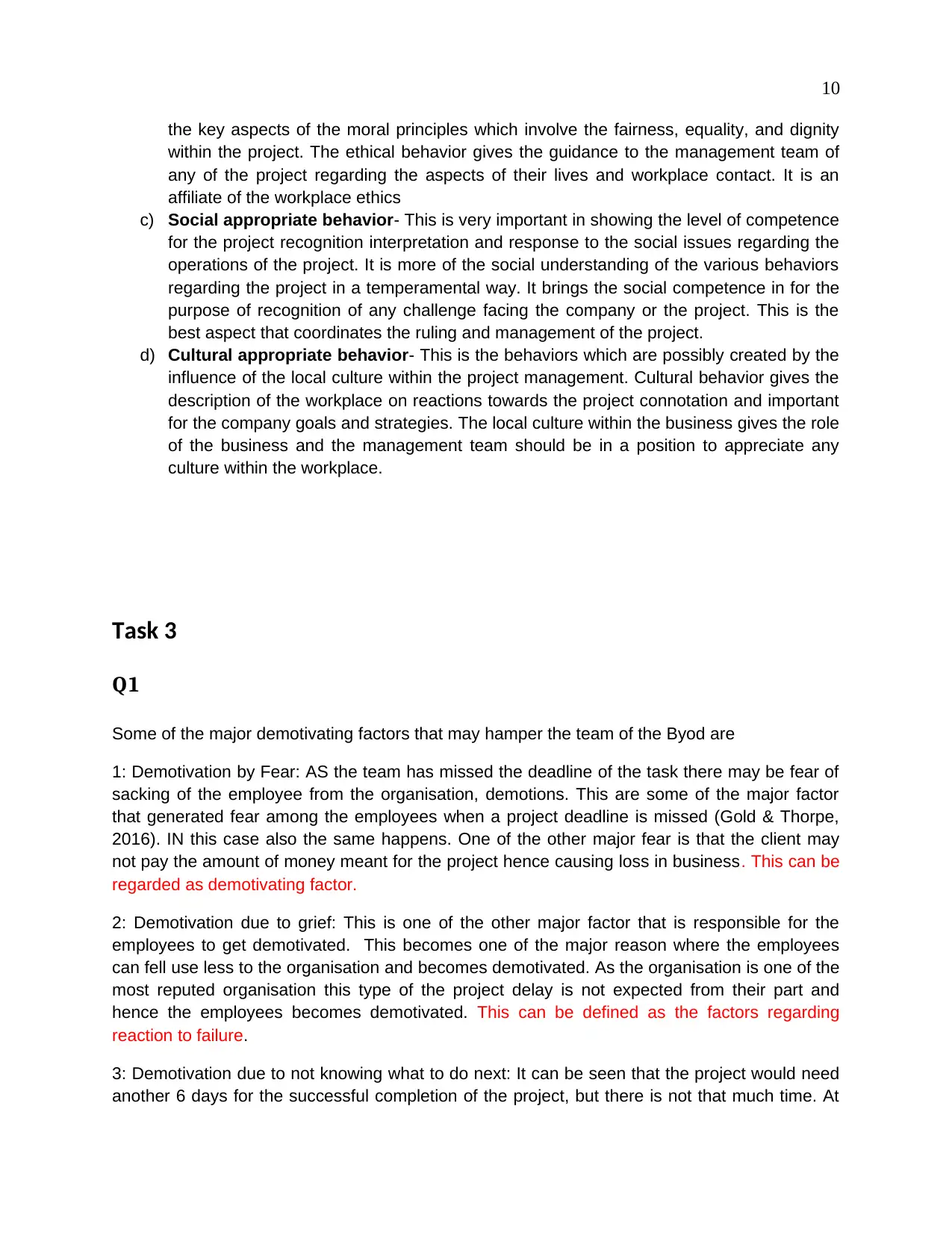
10
the key aspects of the moral principles which involve the fairness, equality, and dignity
within the project. The ethical behavior gives the guidance to the management team of
any of the project regarding the aspects of their lives and workplace contact. It is an
affiliate of the workplace ethics
c) Social appropriate behavior- This is very important in showing the level of competence
for the project recognition interpretation and response to the social issues regarding the
operations of the project. It is more of the social understanding of the various behaviors
regarding the project in a temperamental way. It brings the social competence in for the
purpose of recognition of any challenge facing the company or the project. This is the
best aspect that coordinates the ruling and management of the project.
d) Cultural appropriate behavior- This is the behaviors which are possibly created by the
influence of the local culture within the project management. Cultural behavior gives the
description of the workplace on reactions towards the project connotation and important
for the company goals and strategies. The local culture within the business gives the role
of the business and the management team should be in a position to appreciate any
culture within the workplace.
Task 3
Q1
Some of the major demotivating factors that may hamper the team of the Byod are
1: Demotivation by Fear: AS the team has missed the deadline of the task there may be fear of
sacking of the employee from the organisation, demotions. This are some of the major factor
that generated fear among the employees when a project deadline is missed (Gold & Thorpe,
2016). IN this case also the same happens. One of the other major fear is that the client may
not pay the amount of money meant for the project hence causing loss in business. This can be
regarded as demotivating factor.
2: Demotivation due to grief: This is one of the other major factor that is responsible for the
employees to get demotivated. This becomes one of the major reason where the employees
can fell use less to the organisation and becomes demotivated. As the organisation is one of the
most reputed organisation this type of the project delay is not expected from their part and
hence the employees becomes demotivated. This can be defined as the factors regarding
reaction to failure.
3: Demotivation due to not knowing what to do next: It can be seen that the project would need
another 6 days for the successful completion of the project, but there is not that much time. At
the key aspects of the moral principles which involve the fairness, equality, and dignity
within the project. The ethical behavior gives the guidance to the management team of
any of the project regarding the aspects of their lives and workplace contact. It is an
affiliate of the workplace ethics
c) Social appropriate behavior- This is very important in showing the level of competence
for the project recognition interpretation and response to the social issues regarding the
operations of the project. It is more of the social understanding of the various behaviors
regarding the project in a temperamental way. It brings the social competence in for the
purpose of recognition of any challenge facing the company or the project. This is the
best aspect that coordinates the ruling and management of the project.
d) Cultural appropriate behavior- This is the behaviors which are possibly created by the
influence of the local culture within the project management. Cultural behavior gives the
description of the workplace on reactions towards the project connotation and important
for the company goals and strategies. The local culture within the business gives the role
of the business and the management team should be in a position to appreciate any
culture within the workplace.
Task 3
Q1
Some of the major demotivating factors that may hamper the team of the Byod are
1: Demotivation by Fear: AS the team has missed the deadline of the task there may be fear of
sacking of the employee from the organisation, demotions. This are some of the major factor
that generated fear among the employees when a project deadline is missed (Gold & Thorpe,
2016). IN this case also the same happens. One of the other major fear is that the client may
not pay the amount of money meant for the project hence causing loss in business. This can be
regarded as demotivating factor.
2: Demotivation due to grief: This is one of the other major factor that is responsible for the
employees to get demotivated. This becomes one of the major reason where the employees
can fell use less to the organisation and becomes demotivated. As the organisation is one of the
most reputed organisation this type of the project delay is not expected from their part and
hence the employees becomes demotivated. This can be defined as the factors regarding
reaction to failure.
3: Demotivation due to not knowing what to do next: It can be seen that the project would need
another 6 days for the successful completion of the project, but there is not that much time. At
Paraphrase This Document
Need a fresh take? Get an instant paraphrase of this document with our AI Paraphraser
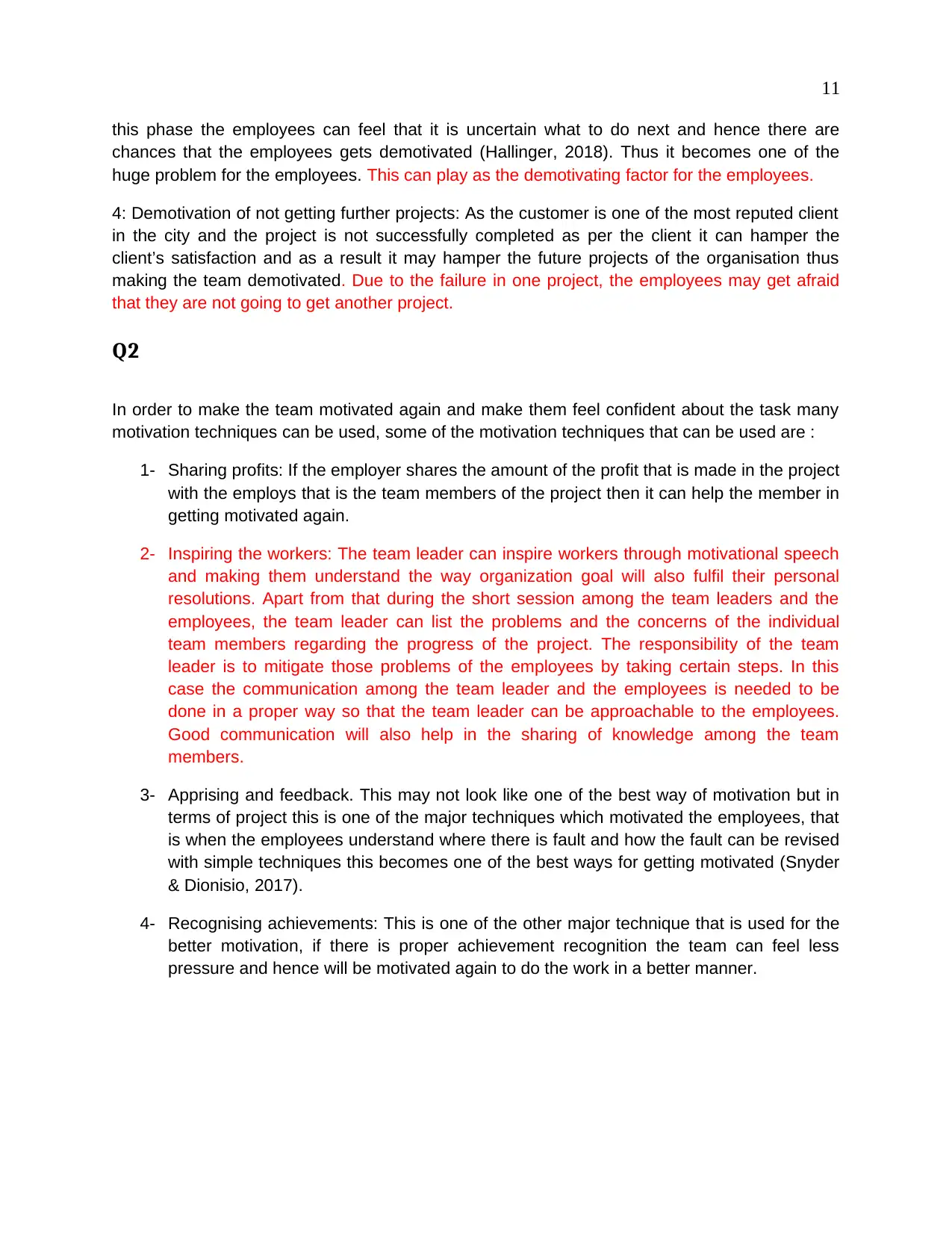
11
this phase the employees can feel that it is uncertain what to do next and hence there are
chances that the employees gets demotivated (Hallinger, 2018). Thus it becomes one of the
huge problem for the employees. This can play as the demotivating factor for the employees.
4: Demotivation of not getting further projects: As the customer is one of the most reputed client
in the city and the project is not successfully completed as per the client it can hamper the
client’s satisfaction and as a result it may hamper the future projects of the organisation thus
making the team demotivated. Due to the failure in one project, the employees may get afraid
that they are not going to get another project.
Q2
In order to make the team motivated again and make them feel confident about the task many
motivation techniques can be used, some of the motivation techniques that can be used are :
1- Sharing profits: If the employer shares the amount of the profit that is made in the project
with the employs that is the team members of the project then it can help the member in
getting motivated again.
2- Inspiring the workers: The team leader can inspire workers through motivational speech
and making them understand the way organization goal will also fulfil their personal
resolutions. Apart from that during the short session among the team leaders and the
employees, the team leader can list the problems and the concerns of the individual
team members regarding the progress of the project. The responsibility of the team
leader is to mitigate those problems of the employees by taking certain steps. In this
case the communication among the team leader and the employees is needed to be
done in a proper way so that the team leader can be approachable to the employees.
Good communication will also help in the sharing of knowledge among the team
members.
3- Apprising and feedback. This may not look like one of the best way of motivation but in
terms of project this is one of the major techniques which motivated the employees, that
is when the employees understand where there is fault and how the fault can be revised
with simple techniques this becomes one of the best ways for getting motivated (Snyder
& Dionisio, 2017).
4- Recognising achievements: This is one of the other major technique that is used for the
better motivation, if there is proper achievement recognition the team can feel less
pressure and hence will be motivated again to do the work in a better manner.
this phase the employees can feel that it is uncertain what to do next and hence there are
chances that the employees gets demotivated (Hallinger, 2018). Thus it becomes one of the
huge problem for the employees. This can play as the demotivating factor for the employees.
4: Demotivation of not getting further projects: As the customer is one of the most reputed client
in the city and the project is not successfully completed as per the client it can hamper the
client’s satisfaction and as a result it may hamper the future projects of the organisation thus
making the team demotivated. Due to the failure in one project, the employees may get afraid
that they are not going to get another project.
Q2
In order to make the team motivated again and make them feel confident about the task many
motivation techniques can be used, some of the motivation techniques that can be used are :
1- Sharing profits: If the employer shares the amount of the profit that is made in the project
with the employs that is the team members of the project then it can help the member in
getting motivated again.
2- Inspiring the workers: The team leader can inspire workers through motivational speech
and making them understand the way organization goal will also fulfil their personal
resolutions. Apart from that during the short session among the team leaders and the
employees, the team leader can list the problems and the concerns of the individual
team members regarding the progress of the project. The responsibility of the team
leader is to mitigate those problems of the employees by taking certain steps. In this
case the communication among the team leader and the employees is needed to be
done in a proper way so that the team leader can be approachable to the employees.
Good communication will also help in the sharing of knowledge among the team
members.
3- Apprising and feedback. This may not look like one of the best way of motivation but in
terms of project this is one of the major techniques which motivated the employees, that
is when the employees understand where there is fault and how the fault can be revised
with simple techniques this becomes one of the best ways for getting motivated (Snyder
& Dionisio, 2017).
4- Recognising achievements: This is one of the other major technique that is used for the
better motivation, if there is proper achievement recognition the team can feel less
pressure and hence will be motivated again to do the work in a better manner.
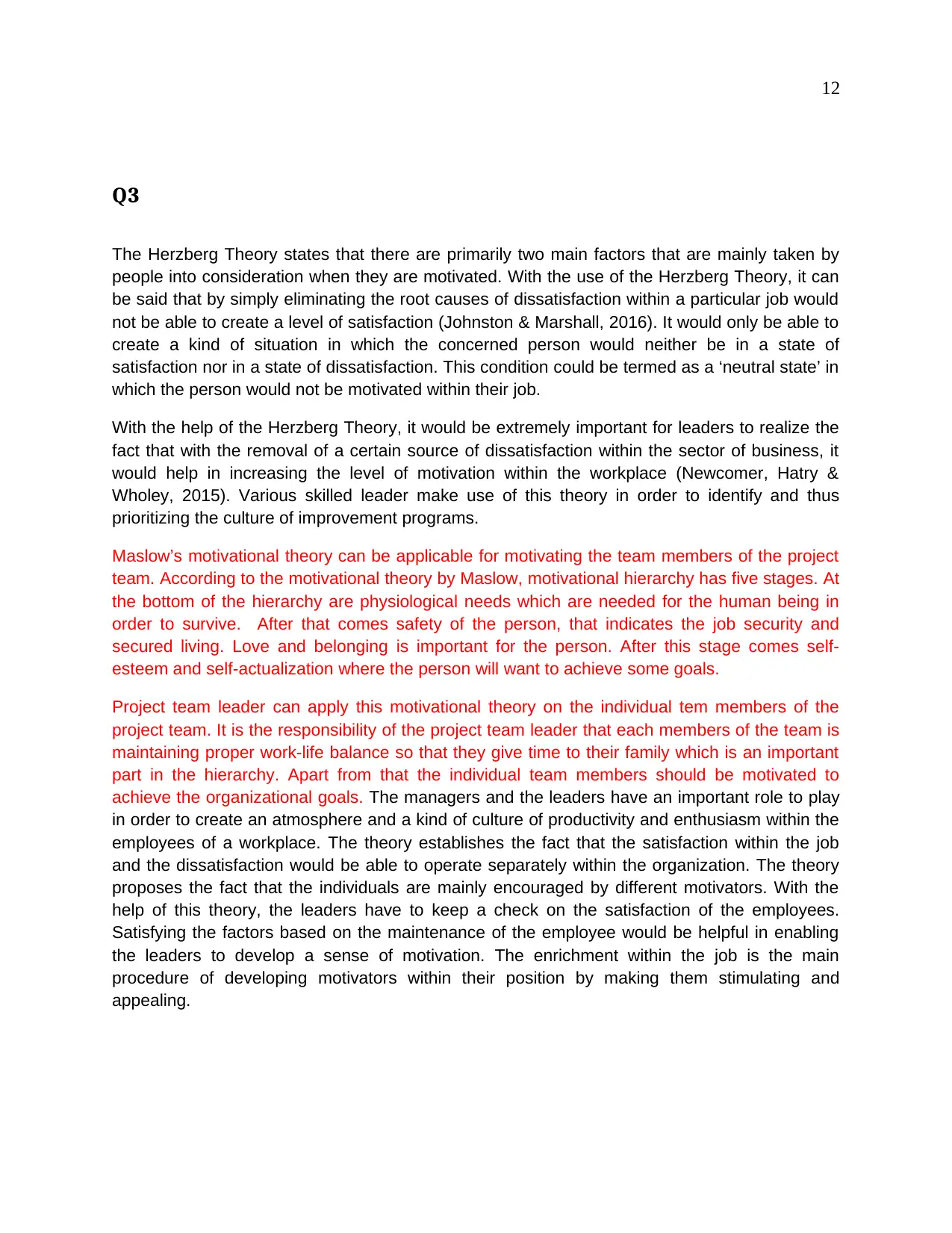
12
Q3
The Herzberg Theory states that there are primarily two main factors that are mainly taken by
people into consideration when they are motivated. With the use of the Herzberg Theory, it can
be said that by simply eliminating the root causes of dissatisfaction within a particular job would
not be able to create a level of satisfaction (Johnston & Marshall, 2016). It would only be able to
create a kind of situation in which the concerned person would neither be in a state of
satisfaction nor in a state of dissatisfaction. This condition could be termed as a ‘neutral state’ in
which the person would not be motivated within their job.
With the help of the Herzberg Theory, it would be extremely important for leaders to realize the
fact that with the removal of a certain source of dissatisfaction within the sector of business, it
would help in increasing the level of motivation within the workplace (Newcomer, Hatry &
Wholey, 2015). Various skilled leader make use of this theory in order to identify and thus
prioritizing the culture of improvement programs.
Maslow’s motivational theory can be applicable for motivating the team members of the project
team. According to the motivational theory by Maslow, motivational hierarchy has five stages. At
the bottom of the hierarchy are physiological needs which are needed for the human being in
order to survive. After that comes safety of the person, that indicates the job security and
secured living. Love and belonging is important for the person. After this stage comes self-
esteem and self-actualization where the person will want to achieve some goals.
Project team leader can apply this motivational theory on the individual tem members of the
project team. It is the responsibility of the project team leader that each members of the team is
maintaining proper work-life balance so that they give time to their family which is an important
part in the hierarchy. Apart from that the individual team members should be motivated to
achieve the organizational goals. The managers and the leaders have an important role to play
in order to create an atmosphere and a kind of culture of productivity and enthusiasm within the
employees of a workplace. The theory establishes the fact that the satisfaction within the job
and the dissatisfaction would be able to operate separately within the organization. The theory
proposes the fact that the individuals are mainly encouraged by different motivators. With the
help of this theory, the leaders have to keep a check on the satisfaction of the employees.
Satisfying the factors based on the maintenance of the employee would be helpful in enabling
the leaders to develop a sense of motivation. The enrichment within the job is the main
procedure of developing motivators within their position by making them stimulating and
appealing.
Q3
The Herzberg Theory states that there are primarily two main factors that are mainly taken by
people into consideration when they are motivated. With the use of the Herzberg Theory, it can
be said that by simply eliminating the root causes of dissatisfaction within a particular job would
not be able to create a level of satisfaction (Johnston & Marshall, 2016). It would only be able to
create a kind of situation in which the concerned person would neither be in a state of
satisfaction nor in a state of dissatisfaction. This condition could be termed as a ‘neutral state’ in
which the person would not be motivated within their job.
With the help of the Herzberg Theory, it would be extremely important for leaders to realize the
fact that with the removal of a certain source of dissatisfaction within the sector of business, it
would help in increasing the level of motivation within the workplace (Newcomer, Hatry &
Wholey, 2015). Various skilled leader make use of this theory in order to identify and thus
prioritizing the culture of improvement programs.
Maslow’s motivational theory can be applicable for motivating the team members of the project
team. According to the motivational theory by Maslow, motivational hierarchy has five stages. At
the bottom of the hierarchy are physiological needs which are needed for the human being in
order to survive. After that comes safety of the person, that indicates the job security and
secured living. Love and belonging is important for the person. After this stage comes self-
esteem and self-actualization where the person will want to achieve some goals.
Project team leader can apply this motivational theory on the individual tem members of the
project team. It is the responsibility of the project team leader that each members of the team is
maintaining proper work-life balance so that they give time to their family which is an important
part in the hierarchy. Apart from that the individual team members should be motivated to
achieve the organizational goals. The managers and the leaders have an important role to play
in order to create an atmosphere and a kind of culture of productivity and enthusiasm within the
employees of a workplace. The theory establishes the fact that the satisfaction within the job
and the dissatisfaction would be able to operate separately within the organization. The theory
proposes the fact that the individuals are mainly encouraged by different motivators. With the
help of this theory, the leaders have to keep a check on the satisfaction of the employees.
Satisfying the factors based on the maintenance of the employee would be helpful in enabling
the leaders to develop a sense of motivation. The enrichment within the job is the main
procedure of developing motivators within their position by making them stimulating and
appealing.
⊘ This is a preview!⊘
Do you want full access?
Subscribe today to unlock all pages.

Trusted by 1+ million students worldwide
1 out of 15
Related Documents
Your All-in-One AI-Powered Toolkit for Academic Success.
+13062052269
info@desklib.com
Available 24*7 on WhatsApp / Email
![[object Object]](/_next/static/media/star-bottom.7253800d.svg)
Unlock your academic potential
Copyright © 2020–2025 A2Z Services. All Rights Reserved. Developed and managed by ZUCOL.





